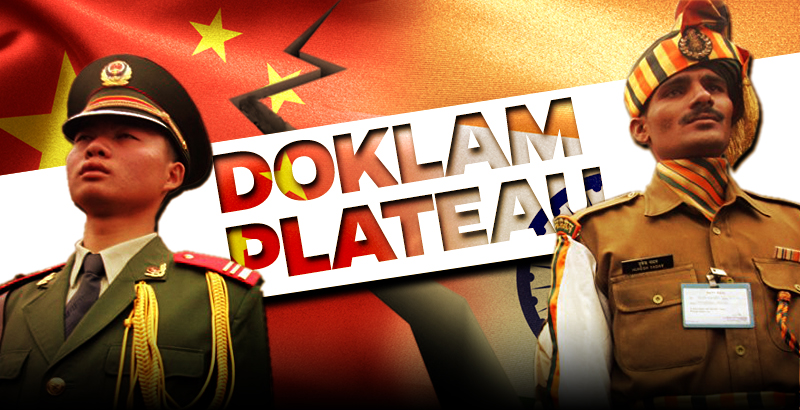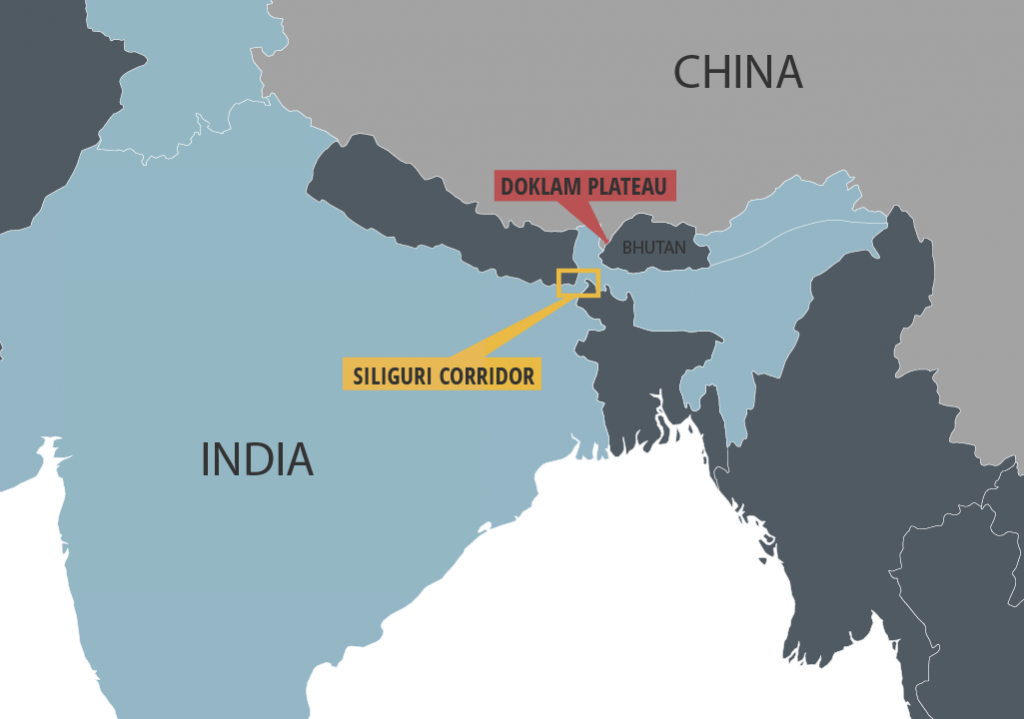
Written by J.Hawk exclusively for SouthFront
In June 2017, Chinese effort to extend a road on the Doklam Plateau provoked a militarized confrontation as India rushed troops to the area in order to prevent the construction. On July 2, 2017, the head of the, the People’s Republic of China Ministry of Defense Center for International Security Cooperation Zhou Bo warned that Indian forces on the Doklam Plateau ought depart the area, lest they wish to provoke Chinese military action. In response, Indian authorities ordered ethnic Chinese villagers on the plateau to evacuate themselves from the area.

The plateau status is a subject of dispute between the PRC and the Kingdom of Bhutan, the latter being a close ally of India which supports Bhutan’s claim to it, fearing that China’s control would endanger the Siliguri Corridor, the so-called “Chicken’s Neck”, a relatively strip of land that connects India’s eastern provinces to the rest of the country. Considering that the escalation of tensions with India is coinciding with aggressive US moves in the South China Sea, the warlike US rhetoric aimed at North Korea, the threat of US economic warfare against China’s alleged “unfair trade practices”, and also an escalation of fighting between Pakistan and India in Kashmir, the Doklam Plateau confrontation should not be viewed in separation from the other developments.

Toward Double Containment
It was evident already in the late 1990s that Washington was viewing China as the next challenger to its hegemony and was taking measures to ensure China’s power could be crippled, when necessary. The world has lived in the shadow of 9/11 for so long that it’s easy to forget the April 2001 EP-3 incident near Hainan Island, or Secretary of Defense Donald Rumsfeld’s efforts to reorient the US military toward waging space-aero-naval warfare against an unspecified nuclear-armed adversary that, while unnamed, was almost certainly China. The pre-9/11 plans to reduce US Army’s divisions very much suggest this doctrine was not being prepared against Russia.
However, 9/11 intervened and distracted the US for well over a decade, during which Russia staged a spectacular recovery which prompted the Obama Administration to view the weakening of Russia as a middle-term objective in the ultimate effort to politically subjugate China. One can readily imagine a President Navalny, Kasyanov, or Nemtsov cooperate with the US in depriving China of the ability to procure Russian gas, oil, and military technology.
With Russia proving a tougher nut to crack than Obama Administration anticipated, Trump appeared to opt for an alliance with Russia against China. It can be most charitably described as a vain hope–US post-Cold War foreign policy has been so duplicitous and opportunistic that no Russian president could possibly trust the US to hold up its end of the bargain in that kind of a relationship, which means that Russia and China are far more likely to view each other as credible partners than the US. But Trump’s apparent plan was quickly thwarted by the US “deep state”, and the two sides seem to have reached a compromise by…simultaneously launching a “cold war” against Russia and China.
A pro-US map shows the alleged situation in the region in light of the US-China geopolitical standoff:

The stepped up confrontations in the South China Sea, the US outreach to India, Myanmar, Philippines, and Vietnam, the tough talk of economic sanctions in response to alleged Chinese aluminum and steel “dumping” and “intellectual property” violations, and most recently the use of North Korea’s highly exaggerated nuclear “threat” as a means to justify economic sanctions against Chinese entities (the last step highly reminiscent of the use of Ukraine to launch economic warfare against Russia), are all part of the US “cold war” against China. This war has not yet escalated to the “hybrid” level (unless one counts the support for the “pro-democracy” movement in Hong-Kong), but the trend is unmistakable.
India, in particular, seems to play an important role in this scheme, and unfortunately Narendra Modi has not been able to resist the temptation of seeking Western favor in return for his participation in the containment of China. While India has long been a major procurer of Russian weapons, there is an evident drift in the direction of the US and the EU, with the purchase of Rafale fighters, P-8 maritime patrol aircraft, and AH-64 Apache attack helicopters. In August 2017, US Pacific Command commander Admiral Harry Harris said the US stood ready to help India modernize its armed forces, and the Indian procurement of US weapons is expected to rise into the billions of dollars in coming years. India’s potentially hostile stance toward China, and its potential ability to dominate the Indian Ocean, could spell trouble for China’s maritime trade routes to the Middle East, Africa, and Europe.
The Middle Kingdom Strikes Back
It is equally evident that China does not intend to sit idly by and watch itself become encircled by a US-led alliance capable of curtailing its trade with the EU. One can see these efforts in Beijing’s unyielding stance on South China Sea, the growing rapprochement with Russia, continued alliance with Pakistan, a base in Djibouti, and now the confrontation on the Doklam Plateau.
If the situation were to escalate, it would be the first large-scale conflict between India and China since the brief 1962 war in Aksai Chin and the North-East Frontier Agency in which India suffered some 7 thousand irretrievable military casualties (killed, captured, missing), or about 10 times PLA’s losses.
While that conflict took place over five decades ago, it is likely that in a new clash the outcome would be largely similar. While India’s military prides itself on having combat experience in Kashmir, that conflict is of a protracted, debilitating kind that actually undermines combat effectiveness and morale. While the PLA lacks recent combat experience, it is evident from its appearances at a variety of Army Games in Russia, including the Tank Biathlon, that it is striving to attain a high degree of proficiency. The recent demonstration of a brand new light tank design to be used in mountainous terrain unsuitable for MBTs suggests doctrinal and equipment adaptation to a variety of theaters, including the Sino-Indian border. Finally, in any such conflict China’s heavy investment in Tibet infrastructure would give it the upper hand over India, since the conflict would in the end come down to the ability to sustain a large fighting force on the “roof of the world.”
Conclusions
But Beijing’s aim does not appear to be the Plateau itself. Rather, Beijing appears to be signaling to New Delhi its intent to make its potential anti-China moves in an alliance with the US costly. The Doklam Plateau could become yet another low intensity frontline for India, to be added to Kashmir.
Russia, being a strategic partner to both powers, is caught in the middle of this dispute, which makes it an ideal candidate for mediating the conflict. The golden opportunity to do so is right around the corner: the September 2017 BRICS summit that will be held in China. Barring a local incident that triggers an escalation, it is unlikely either side will make any decisive moves prior to a diplomatic face-off.





